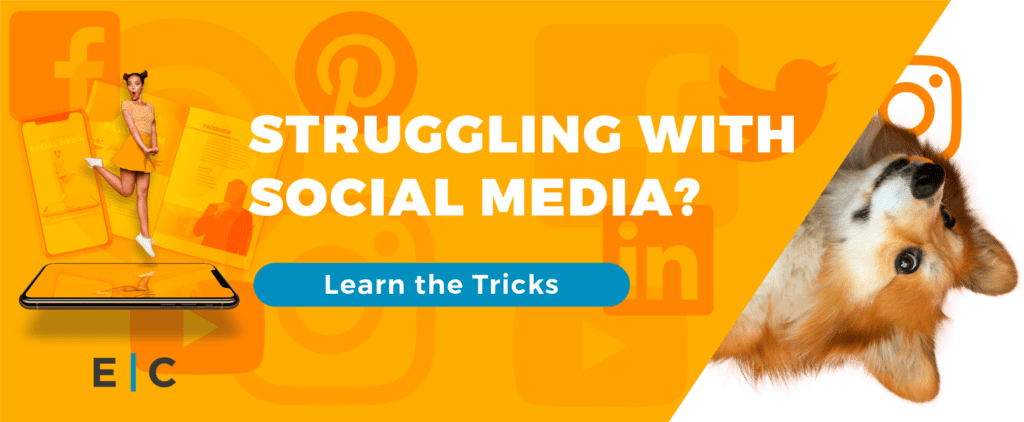Are you related to, or friends with, a luddite? They still use a rotary phone, only communicate through snail mail, and listen to their favorite music on cassette tapes. In other words, they don’t adapt to changes over time.
That’s exactly how people perceive brands that still use outdated, ineffective social media tactics.
Social media marketing is constantly evolving. That means your social media tactics should also evolve to meet new demands, including mastery of paid social media and social content diversity. We’ve pulled data based on our own social media marketing experiences to help you answer an important question: are my current social media marketing tactics still effective?
Read the Ultimate Guide to Social Media Best Practices
Outdated social media tactics can be separated into three categories:
- Outdated best practices
- No longer effective
- Completely dead
1. Outdated Best Practices
Publishing duplicate content on all platforms
Back in the day (you know, like last year), you could share the same content on Facebook, Twitter, and LinkedIn. Today, things have changed and the audience for each social platform has become more segmented. That means your posts now need to be optimized for each platform—this is known as pillaring. Facebook and LinkedIn share similarities, but content on Twitter, Instagram, Pinterest and every other platform requires a custom approach.
Check out these examples of Facebook, Twitter, and Instagram post that are all on similar topics, but uniquely different in presentation:
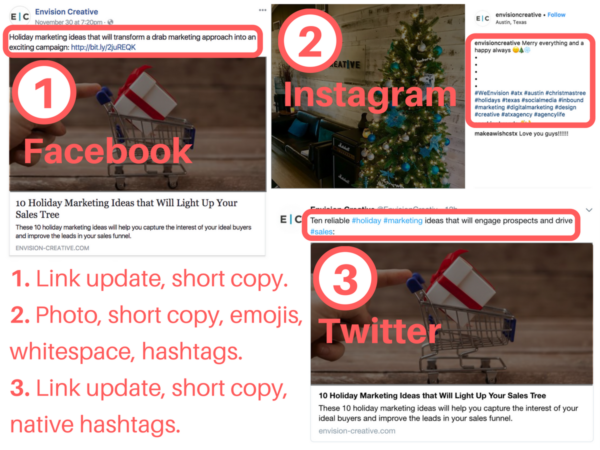
Don’t rely on auto-posting
Automating your social posting can help save time and improve productivity, but it should never be used to schedule content far into the future. Best practices call for scheduling content for a maximum of 1 ½ weeks at one time. Scheduling content for shorter stretches of time allows you to capitalize on relevant topics and trends that might occur.
Try it once and stop
Have you tried Facebook ads before? How about video content? A lot of people try things once, fail, and then never give them another chance. It takes time and experimentation to figure out what does and doesn’t work on social media for your brand. If you tried Facebook ads once and didn’t like the results, try them again and carefully track your process so you can review it later to see how things can be improved.
2. No Longer Effective
These are the tactics that no longer work thanks to changes in the way online audiences consume information and interact with brands on social media.
Tagging influencers for engagement
This used to be all the rage on Instagram. Now it’s considered bad practice and can get your account flagged for “spam.” Thankfully, there are still some legitimate scenarios where you can tag influencers to increase reach and engagement:
- If you re-share their content and give them credit as the creator
- If you’ve mentioned them in an article, blog post, or another resource
- If you saw them speak at an event and want to give them a shout out
Just be sure not to tag influencers just for the sake of tagging them and you’ll be safe.
Asking people to share your content
Another tactic that’s gone out of style. It makes your brand look needy—dare we say, pitiful even—and has virtually no effect most of the time. The only exception is when you’re running a competition, giveaway, or sweepstakes. That’s when you can go into cheerleader mode and promote sharing your content without shame:
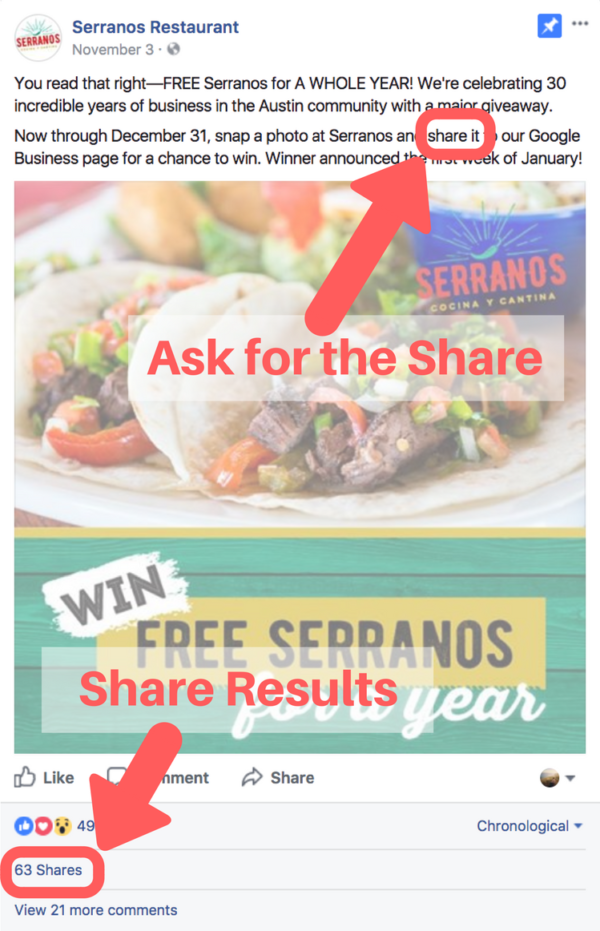
Being self-promotional
Self-promotion often comes across as bragging and makes the brand appear egotistical and unapproachable. While in-your-face promotional content is no longer effective, there are acceptable alternative methods that help promote your brand:
- Brand culture posts (pictures, videos, and articles)
- Customer reviews and testimonials
- Company events and conferences
- Helpful or educational content—resources, case studies, and courses
It’s also important to enhance your brand’s authority by sharing third-party content from respected sites and publications. This allows you to create a more dynamic mix of native and curated content with which your audience will want to engage.
Posting tweets on Facebook
Seriously, this technique is so old that it’s the caveman of social media methods. It’s an antiquated cross-posting practice that’s no longer effective for several reasons:
- First, Facebook and Twitter have completely different audience cultures.
- Second, some Facebook user don’t have a Twitter account, so each time they click on a Tweet posted to Facebook they won’t be able to access your content.
- And finally, you’re not doing your brand any favors by cluttering your Facebook Page with tweets when you could be creating custom posts and content for each platform.
Relying 100% on organic posting to reach your audience
The days of organic reach are diminishing rapidly. Social platforms—Facebook especially—are constantly updating their algorithms to favor paid content. If you aren’t familiar with advertising on social media, now is the time to learn.
Publishing content only in real-time
Publishing all of your content in real-time is a bad idea, especially if you’re managing multiple social media accounts. It kills productivity and establishes an inconsistent posting frequency on your social accounts. A pre-scheduled posting routine is much more efficient. Remember that best practice we discussed earlier—schedule content 1 ½ weeks out at a time? Try posting a mixture of evergreen content that can be scheduled in advance, and some ad hoc posts that are timelier
- Examples of evergreen content:
- Leadership articles
- Original research
- Examples of ad hoc content:
- Company culture photos
- Live conference updates
See the Answers to 13 Social Media Questions Every Business Owner Asks
3. Completely Dead
If you’re still exercising these ancient tactics, there’s no doubt about it—you’re damaging your brand image. The safest course of action is to stop using them as soon as possible.
Automated “Thanks for following” messages
Twitter is notorious for bad auto direct messages that are generic, boring, and ineffective. They usually go something like this:
- Thanks for following me, I look forward to reading your Tweets!
- Thanks for following me! Visit my Instagram account for more great content [insert link here]!
Everyone knows these messages are automated so they come across as inauthentic and spammy. If you’re sending these automatic messages, turn them off ASAP. Thankfully, automatic replies have evolved and can be used to send valuable content offers and unique messages to new followers. Instead of the generic “thank you,” try customizing your message to resonate with your new followers and offer them something they’ll engage with. Check out this great example of a non-generic “thanks for following” message on twitter:
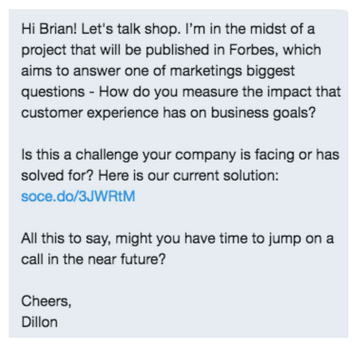
Hashtag stuffing on Twitter & Instagram
Hashtags can be a great way to increase the reach of your content, but excessive hashtag usage is a bad idea for several reasons.
- First, it’s hard to distinguish what’s being said.
- Second, it looks like a big blob of mashed up words.
- Third, it once again makes your posts look like spam.
Just check out these thoroughly painful examples if you don’t believe us:


Only sharing text & image posts
The days of text and image posts as the lone type of social post are long gone. Your audience needs a variety of interesting, valuable content if you expect them to continue following your brand. Incorporate new content forms to spice up your social accounts:
- Free resources
- Videos
- GIFs
- Infographics
- Live videos
- Giveaways
Randomly posting, rather than scheduling
Posting when you feel like it, or only when you have time is a bad idea. You can’t expect to gain any traction on social media if you only post a few updates every week. Here are some recommended posting frequencies, but keep in mind that recommended frequencies should be based on industry, type of business, the size of the audience, and how engaged the audience is:
- Facebook: 5-10 posts per week
- Twitter: 8-10 posts per day (including retweets)
- Instagram: 1 per day
- Pinterest: 5-10 posts per day
- LinkedIn: 1 per day (Monday – Friday)
- Google+: 1 per day
That might seem like a lot of posting, but it’s necessary to keep your brand relevant online. Scheduling your content ahead of time makes the process much more manageable. Use a social media content calendar—sometimes called an editorial calendar—to organize your content into a consistent posting schedule.
Download My Social Media Content Calendar Template Now
Hijacking trending topics & hashtags
As tempting as it might be to talk about the Kardashian’s latest lipstick color on Twitter, it’s a complete waste if your brand doesn’t have anything to do with the cosmetics industry. Never hijack a trending topic or hashtag just because it’s popular. Remember when DiGiorno’s decided to hijack #WhyIStayed hashtag? They’re probably still recovering from that disaster:
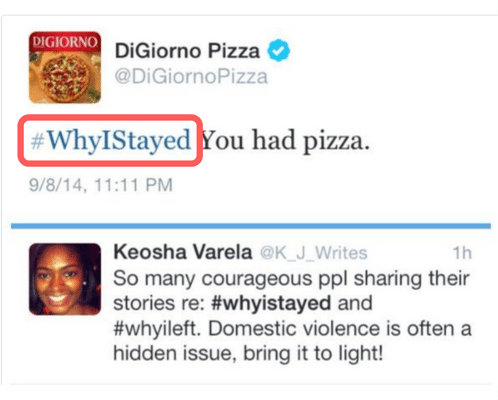
First and foremost a hashtag needs to relate to your business and be valuable to your audience. The best practice for hashtags is to use a few really good ones that convey the core message of your social post.
If you avoid these outdated tactics, your social media efforts should be golden. Keep in mind that staying on top of changes in social media is crucial to your success. Periodically search for news on each platform to stay updated on the latest changes.
-FINAL(01-00)-White&Blue-01.svg)

